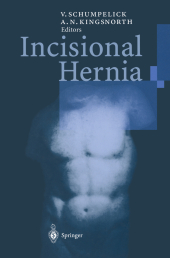 Neuerscheinungen 2011Stand: 2020-01-07 |
Schnellsuche
ISBN/Stichwort/Autor
|
Herderstraße 10
10625 Berlin
Tel.: 030 315 714 16
Fax 030 315 714 14
info@buchspektrum.de |

Andrew N. Kingsnorth, Volker Schumpelick
(Beteiligte)
Incisional Hernia
Herausgegeben von Schumpelick, Volker; Kingsnorth, Andrew N.
Softcover reprint of the original 1st ed. 1999. 2011. xxv, 511 S. 80 Tabellen. 235 mm
Verlag/Jahr: SPRINGER, BERLIN 2011
ISBN: 3-642-64267-5 (3642642675)
Neue ISBN: 978-3-642-64267-8 (9783642642678)
Preis und Lieferzeit: Bitte klicken
All general surgeons, and especially hernia surgeons, will benefit from this book. It contains a complete update on the research and pathogenesis of the incisional hernia. The volume describes all important diagnostic and therapeutic procedures and evaluates the appropriate use of each procedure for each particular case. Pitfalls and unresolved issues are discussed in depth, and experts of international standing weigh in on each topic.
´I Anatomy of the Abdominal Wall.- 1 Descriptive Anatomy.- 1.1 Skin.- 1.1.1 Surgical Applications.- 1.2 Subcutaneous Tissue.- 1.2.1 Vascular Supply of the Skin and Subcutaneous Fat.- 1.2.2 Surgical Applications.- 1.3 Surgical Anatomy of the Umbilical Region.- 1.4 Flat Muscles of the Anterior Abdominal Wall and the Rectus Abdominis and Pyramidalis Muscles.- 1.4.1 External Oblique Fascia (Innominate Fascia of Gallaudet).- 1.4.2 External Oblique Aponeurosis.- 1.4.3 Inguinal (Poupart´s) Ligament.- 1.4.4 Ligament of Gimbernat (Lacunar Ligament).- 1.4.5 Internal Oblique Muscle and Aponeurosis.- 1.4.6 Transversus Abdominis Muscle and Aponeurosis.- 1.4.7 Arch of the Internal Oblique and Transversus Abdominis Muscles.- 1.4.8 Conjoined Area.- 1.4.9 Rectus Abdominis Muscle and its Sheath.- 1.4.10 Linea Alba.- 1.5 Fascia Transversalis.- 1.5.1 Thickenings of the Fascia Transversalis.- 1.6 Spaces.- 1.6.1 Vascular Space.- 1.6.2 Space of Bogros.- 1.7 Vascularization of the Muscles.- 1.8 Innervation of the Abdominal Wall.- 1.8.1 Thoracoabdominal Nerves.- 1.8.2 Ilioinguinal Nerve.- 1.8.3 Iliohypogastric Nerve.- 1.8.4 Genitofemoral Nerve.- 1.8.5 Surgical Applications.- 1.9 Peritoneum.- 1.10 Fossae of the Anterior Abdominal Wall.- 1.11 Myopectineal Orifice of Fruchaud.- 1.12 Cooper´s Ligament.- 1.13 Femoral Canal and Femoral Sheath.- 1.14 "Good Stuff".- 1.15 Discussion.- References.- 2 Functional Anatomy.- 2.1 Upper Abdominal Zone Herniation.- 2.2 Incidence.- 2.3 Pathological Anatomy.- 2.4 Repair Techniques.- 2.5 Condensation and Sling of the Fascia Transversalis.- 2.6 Discussion.- References.- 3 Surgical Anatomy.- 3.1 Introduction.- 3.2 Skin and Subcutis.- 3.3 Muscles of the Abdominal Wall.- 3.3.1 Rectus Abdominis Muscle.- 3.3.2 Oblique External Muscle of the Abdomen.- 3.3.3 Oblique Internal Muscle of the Abdomen.- 3.3.4 Transverse Muscle of the Abdomen.- 3.4 Fascial Structures.- 3.4.1 Sheath of Rectus Abdominis Muscle.- 3.4.2 Linea Alba.- 3.4.3 Fascia Transversalis.- 3.5 Preperitoneal Space.- 3.6 Inguinal Falx (or Conjoined Tendon or Henle´s Ligament).- 3.7 Interfoveolar (Hesselbach´s) Ligament.- 3.8 Discussion.- References.- II Wound Healing.- 4 Fascial Metabolic Defects.- 4.1 Introduction.- 4.2 Personal Observations.- 4.3 Hypothesis.- 4.4 Pulmonary Emphysema.- 4.5 Metastatic Emphysema.- 4.6 Supporting Data.- 4.7 Proteolysis in Patients with Aneurysm.- 4.8 Congenital and Genetic Influences.- 4.9 Conclusion.- 4.10 Summary.- 4.11 Discussion.- References.- 5 Growth Factors and Hernia.- 5.1 Function.- 5.2 Availability.- 5.3 Experimental Findings.- 5.4 Outlook.- 5.5 Discussion.- References.- III Abdominal Wall Defects.- 6 Primary Hernia.- 6.1 Epigastric Hernia.- 6.2 Anatomy.- 6.3 Umbilical Hernia.- 6.4 Infantile Umbilical Hernia.- 6.5 Acquired Umbilical Hernia.- 6.6 Para-umbilical Hernia.- 6.7 Umbilical Hernia in Adults.- 6.8 Spigelian Hernia.- 6.9 Obturator Hernia.- 6.10 Lumbar Hernia.- 6.11 Discussion.- 7 Nonhernial Defects.- 7.1 Tumor Resection.- 7.2 Trauma.- 7.3 Necrotizing Fasciitis.- 7.4 Laparostomy.- 7.5 Radiotherapy.- 7.6 Donor Defect After a Transverse Rectus Abdominis Musculocutaneous Flap.- 7.7 Prune Belly Syndrome.- 7.8 Congenital Abdominal Wall Necrosis.- 7.9 Discussion.- References.- 8 Acute Wound Failure.- 8.1 Incidence.- 8.2 Pertinent Aspects of Fascial Healing.- 8.3 Choice of Incision.- 8.4 Mechanisms.- 8.5 Choice of Closure.- 8.6 Risk Factors.- 8.7 Role of Infection.- 8.8 Postoperative Increases in Intra-abdominal Pressure.- 8.9 Summary.- 8.10 Discussion.- References.- 9 Natural History and Patient-Related Factors.- 9.1 Introduction.- 9.2 Natural History of Wound Healing.- 9.3 Wound Infection.- 9.4 Patient-Related Risk Factors.- 9.5 Increased Intra-abdominal Pressure.- 9.6 Drugs.- 9.7 Discussion.- References.- 10 Diagnosis of Abdominal Wall Defects.- 10.1Sonography.- 10.1.1 Sonographic Anatomy of the Abdominal Wall.- 10.1.2 Sonograph


